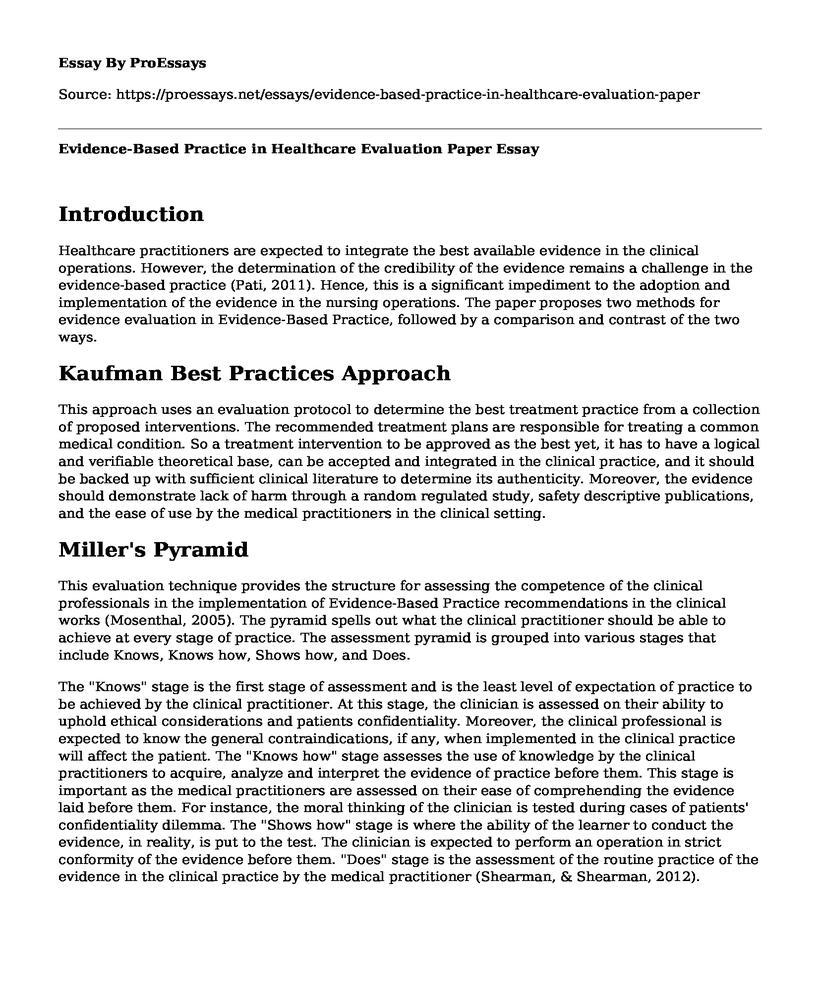Introduction
Healthcare practitioners are expected to integrate the best available evidence in the clinical operations. However, the determination of the credibility of the evidence remains a challenge in the evidence-based practice (Pati, 2011). Hence, this is a significant impediment to the adoption and implementation of the evidence in the nursing operations. The paper proposes two methods for evidence evaluation in Evidence-Based Practice, followed by a comparison and contrast of the two ways.
Kaufman Best Practices Approach
This approach uses an evaluation protocol to determine the best treatment practice from a collection of proposed interventions. The recommended treatment plans are responsible for treating a common medical condition. So a treatment intervention to be approved as the best yet, it has to have a logical and verifiable theoretical base, can be accepted and integrated in the clinical practice, and it should be backed up with sufficient clinical literature to determine its authenticity. Moreover, the evidence should demonstrate lack of harm through a random regulated study, safety descriptive publications, and the ease of use by the medical practitioners in the clinical setting.
Miller's Pyramid
This evaluation technique provides the structure for assessing the competence of the clinical professionals in the implementation of Evidence-Based Practice recommendations in the clinical works (Mosenthal, 2005). The pyramid spells out what the clinical practitioner should be able to achieve at every stage of practice. The assessment pyramid is grouped into various stages that include Knows, Knows how, Shows how, and Does.
The "Knows" stage is the first stage of assessment and is the least level of expectation of practice to be achieved by the clinical practitioner. At this stage, the clinician is assessed on their ability to uphold ethical considerations and patients confidentiality. Moreover, the clinical professional is expected to know the general contraindications, if any, when implemented in the clinical practice will affect the patient. The "Knows how" stage assesses the use of knowledge by the clinical practitioners to acquire, analyze and interpret the evidence of practice before them. This stage is important as the medical practitioners are assessed on their ease of comprehending the evidence laid before them. For instance, the moral thinking of the clinician is tested during cases of patients' confidentiality dilemma. The "Shows how" stage is where the ability of the learner to conduct the evidence, in reality, is put to the test. The clinician is expected to perform an operation in strict conformity of the evidence before them. "Does" stage is the assessment of the routine practice of the evidence in the clinical practice by the medical practitioner (Shearman, & Shearman, 2012).
Compare and Contrast
Both of the evaluation methods require the need for the best possible practice to be adopted as the clinical interventions. For instance, both of the methods advocated for the more natural integration of the proposed clinical approaches in the medical operations. This includes the ease of practice by the healthcare practitioners.
The Miller's pyramid approach is focused on medical staff able to perform the medical operations recommended by the evidence brought forth. Whereas, the Kaufman best practice approaches are centered more on the patient with little regard of the healthcare practitioners. Kaufman best practice approach compares the available methods to select the best one to follow, whereas the Miller's pyramid approach requires the medical practitioner to be able to practice the recommended medical treatment intervention selected.
References
Mosenthal, P. (2005). Tetrahedral and Pyramid Models in Educational Research: A Rejoinder to Fagley and Miller. Review Of Educational Research, 55(1), 5. doi: 10.2307/1170404
Pati, D. (2011). A Framework for Evaluating Evidence in Evidence-Based Design - Debajyoti Pati, 2011. Retrieved from http://journals.sagepub.com/doi/abs/10.1177/193758671100400305?journalCode=hera
Shearman, A., & Shearman, C. (2012). How to practise evidence-based surgery. Surgery (Oxford), 30(9), 481-485. doi: 10.1016/j.mpsur.2012.06.005
Cite this page
Evidence-Based Practice in Healthcare Evaluation Paper . (2022, Jul 27). Retrieved from https://proessays.net/essays/evidence-based-practice-in-healthcare-evaluation-paper
If you are the original author of this essay and no longer wish to have it published on the ProEssays website, please click below to request its removal:
- Clinical Supervision Methods Essay Example
- The Black Americans Community's Determinants of Health Essay Example
- Preliminary Report: Project Mgr Roles, Objectives & Responsibilities - Essay Sample
- Importance of Ensuring That Others Are Aware of Own Whereabouts
- Essay Sample on Nursing Researchers: Uncovering Validity and Relevancy in Studies Using PICOT
- Paper Example on Perinatal Drug Abuse: Neonatal Drug Withdrawal Risk
- 16yo Girl Experiences Anxiety, Fear, Excessive Guilt, Sleepiness, Eating Changes - Free Essay







